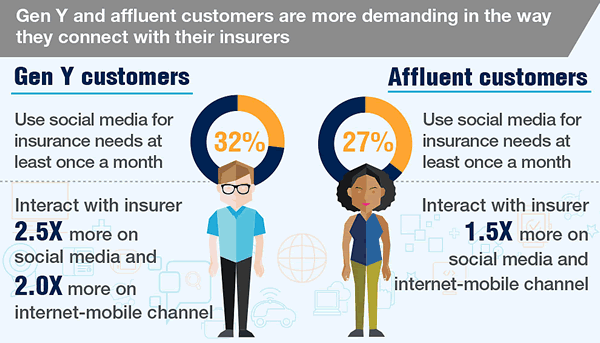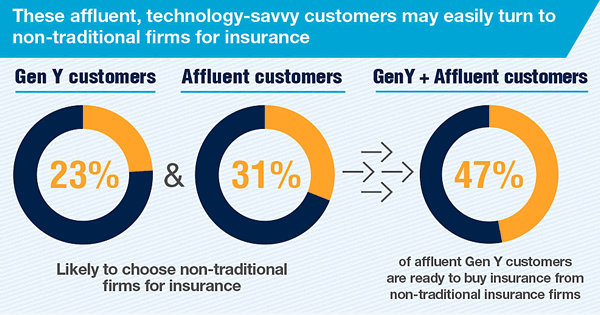Insurance customers have increased expectations, with an important role for younger consumers.
In a video made at the occasion of the World Insurance Report 2016 (see below), Capgemini and Efma emphasize a few focus points of the report, which has been covering important insurance trends for many years now.
A key topic, which is also covered in the report and the infographic accompanying it, is the impact of Generation Y. Reminding us that this (broad) segment, typically characterized as the first generation to have been born in a digital age, will make up 75 percent of the global workforce by 2025, the World Insurance Report 2016 stresses the changed expectations of the Gen Y cohort.

Differences in insurance customer experience perceptions
You know what that means: there is this effect whereby they want to work, engage with business and of course deal with insurance companies and products as they do in other aspects of their lives.
As usual we need to remind that it’s less a generational than a behavioral thing but, nonetheless, the report found that Gen Y is not really happy with customer experience when it concerns insurers.
While the overall customer experience perceptions have improved quite a bit since, for example 2013, when only 30 percent of insurance customers reported a positive overall experience, (it went up to 47 percent in 2016), this is not the case for Gen Y. Only 34 percent of Gen Y customers report a positive insurance experience as the infographic of the World Insurance Report 2016 mentions.
A digital mindset with an open attitude towards FinTech/InsurTech
So, what do insurance companies need to know about Generation Y according to the video?
- They interact with their insurers twice as much as other age groups (both a challenge and an opportunity).
- They display an omni-channel (or channel-agnostic) behavior with a clear preference for digital channels (which, among others, has an impact on insurance claims processing, customer service expectations, etc.).
- They expect this famous seamless and integrated experience across the channels they prefer but, then again, so do all of us, even if the channels might differ a bit.
- They have no real issues buying insurance products from FinTechs/InsurTechs (and so many other ‘places’ and non-insurance companies where you can get insurance nowadays, from online retailers to big retail brands and search engines).

Getting insured: tell me why
Generation Y obviously is not a homogeneous class of consumers and a generational construct. Still, the behavior and expectations of this – large – age group are key for the insurance industry for the very simple reason that today they are their largest target age group. On top of that, in general, they seem to have other attitudes in regards to insurance overall.
Marianne Kutzner, Head of Gen Re Business School, Cologne, wrote a report about it, saying that when it boils down to getting insured, Gen Y needs a “why?”.
It’s important to find the right answer to that “why?” question as younger people often are poorly informed regarding insurances, feel overwhelmed and are not at ease when it concerns dealing with insurance. She advices insurance firms to not provide more information but to tailor the information to the age group in a comprehensive language.
Obviously there is also a difference between younger consumers who don’t work yet, those who work and those who work and have done some important investments already and/or have their own children and family. People do change over time, Gen Y or not. This is crucial: everything is contextual and dynamic.
Digital and online is not always the answer – dissecting Gen Y insurance attitudes and stages
The research Kutzner writes about and which was conducted in Germany also reminds us that we need to take other contextual factors into account such as geography, culture, individuality and the type of insurance interaction/stage/transaction.
Globally, 47% of insurance customers have positive experiences with their insurer, but only 34% of Gen Y customers do (World Insurance Report 2016 infographic).
In Germany, Gen Y for instance by far prefers to visit the offices of an insurer or insurance broker for policies (83 percent) rather than buying insurance online (43 percent) which is in fact their third choice. The second choice is a home visit by an insurance representative (70 percent). For us, being based in Belgium, that’s a very recognizable situation. You can read more about the research with an identification of three types of Gen Y regarding insurance (the carefree and inactive, the competent concerned and the worried and overwhelmed) here.
Get up close, individual and contextual
Increasing customer expectations are a fact and the choice for digital channels in many stages of the insurance lifecycle by younger consumers is clear. But it’s not universal and not equally important in all types of interactions and transactions regarding insurance.
Sure, most of them look online to compare insurance products but in the end it’s about protecting what matters to them and their dear ones and that differs per type of insurance and individual.
Moreover, comparing and checking insurance information is not the same as buying a policy and not the same as having to go through a claims process. As usual there is never a one-size-fits-all approach but by tailoring your information to what individual Gen Y consumers really care about you can make a big difference and here technology comes in the picture as well.
As a reminder: it’s not about the age group, it’s about the behavior so don’t lose track of those very digital savvy, demanding and active consumers that don’t belong to Gen Y at all.

Adapting to Gen Y and the ‘digital first’ customers in insurance
As to the general conclusions on the different behavior of Gen Y consumers as found in the World Insurance Report 2016: it’s clear that these general findings are correct and that you need an adapted approach, both in offering and in narrative.
Just don’t adapt it to Gen Y but to the behavior and needs of individual consumers. And that is another ball game, which requires the use of technologies in combination with an innovative, agile, fast and customer-driven culture for a channel-agnostic world.
Top image: Shutterstock – Copyright: Anze Bizjan – All other images are the property of their respective mentioned owners.

